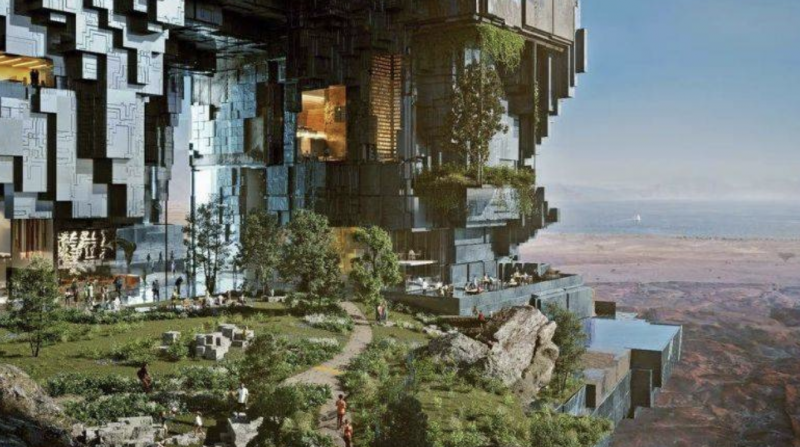
A design plan of the smart city "The Line" in Neom, Tabuk province. (Credit: Neom/AFP)
From 170 to 2.4 kilometers. From 1.5 million to 300,000 residents. Saudi Arabia drastically scaled back the ambitions of The Line for 2020, Bloomberg reported. The Line is the iconic project of NEOM, a futuristic megacity project.
The Line will be built 200 meters wide, without cars or streets, in the middle of the desert in Tabuk province. This smart city was to house its residents in two 500-meter-high mirrored skyscrapers, with zero CO2 emissions.
Widely perceived as a delusion of grandeur, The Line symbolized the modernist avidity of Saudi Crown Prince Mohammed bin Salman (MBS). Its anticipated scale down therefore seems to confirm the skepticism that many observers, experts and architects have expected.
Admission of weakness or pragmatic shift? “The megaprojects served to promote Saudi Arabia as a new state, both domestically and to outsiders,” said Karen Young, senior research scholar at Columbia University’s Center on Global Energy Policy. “Audacity was the point.”
Their value has been estimated at $879 billion, of which only $50 billion in contracts have been awarded so far, said an editorialist at Middle East Economic Digest, at the opening of the Saudi Giga Projects conference in Riyadh in June. “Reducing their size was part of the plan,” Young argued.
Economic landscape
There have been a few successes, however. Progress has been achieved in the surrealistic-looking NEOM city, which is supposed to be fully powered by renewable energy while promising flying cabs, robot housekeepers and phosphorescent sand.
According to the Saudi Sovereign Wealth Fund (SWF)’s recent statements, three of its flagship projects of relatively reasonable size and clearer practicality are nearing completion, which signals that some targets have been met.
The high-end tourist destination Sindala is progressing, the container terminal is scheduled for completion in 2025, and the green hydrogen and ammonia production site will be operational in 2026. Laith Alajlouni, economist at the International Institute for Strategic Studies (IISS), said, “Once the port is up and running, the rest will follow, as the infrastructure for transporting materials to factories and construction projects will be in place, and logistics costs will be lower. We can therefore expect an acceleration in project construction.”
But the international context, where oil prices struggled to exceed $80 since peaking at the start of the war in Ukraine, threatens the finances of the Saudi kingdom, which calculates its budget based on a barrel price above this threshold.
“The new strategy of scaling back megaprojects is aligned with the imperative of accelerating change in the Saudi economic landscape, amid a desire to avoid criticism for spending astronomical sums on unrealistic projects and spaces that are likely to be partially inhabited and therefore unprofitable, when other priorities must be met,” said Grace Najjar, a consultant specializing in project management in the Middle East.
While it may not be able to achieve its initial ambitions, Riyadh’s aim remains to develop its development projects, which are part of the Vision 2030 MBS launched in 2016.
Qiddiya Entertainment City alone, with its gigantic theme park plans southwest of the capital, has over 1,000 billion riyals ($266 billion) in committed expenditure. According to two sources briefed on the project and quoted by Bloomberg, this amount is entirely backed by the SWF and a Saudi developer linked to the fund.
“The injection of funds into these mega projects, particularly The Line, is limiting public spending in other key sectors in Vision 2030, including petrochemicals, mining, green initiatives, energy and technology,” said the expert.
Indeed, the reallocation of the kingdom’s financial resources is one of the main arguments put forward to explain this recalibration, although no details in this regard have filtered through to the SWF’s 2024 budget.
FDI struggling
In reality, Saudi Arabia is struggling to attract the foreign investment needed to develop its projects. The goal of $100 billion in foreign direct investment (FDI) per year by 2030 now seems unattainable. This is due to cumbersome bureaucracy, uncertainty about profitability in a country where everything has yet to be built and the viability of the mega-projects themselves.
Between 2017 and 2022, annual FDI flows into Saudi Arabia averaged just over $17 billion, said Bloomberg. Preliminary data for 2023 show that FDI hit around $19 billion, below the target of $22 billion, according to the Saudi Ministry of Investment.
NEOM, which has a budget of $500 billion, has yet to make serious progress in raising capital, said Bloomberg, quoting sources close to the matter.
The relevant authorities have gone so far as to ask neighboring Kuwait for more than $16 billion to finance several projects, including the futuristic megalopolis, Bloomberg further reported.
For the first time, NEOM is considering a plan to raise up to $1.3 billion from Islamic bonds, or sukuk, to consolidate its financing, it added.
This article was originally published in L'Orient-Le Jour. Translated by Joelle El Khoury.